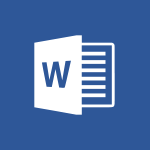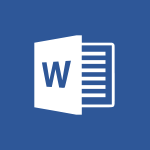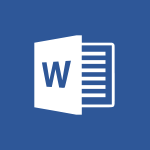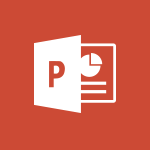Word - Styles Video
In this video, you will learn about the different styles available in Microsoft 365 applications.
The video covers the various styles that can be used in Microsoft 365, such as formatting options, templates, and design elements.
It demonstrates how to apply styles to documents, presentations, and spreadsheets, making your work visually appealing and professional.
This will help you enhance your documents and presentations, making them more engaging and impactful.
- 1:49
- 2261 views
-
OneDrive - What is OneDrive ?
- 01:14
- Viewed 1574 times
-
Outlook - Create and modify a group
- 2:19
- Viewed 4351 times
-
OneDrive - Edit, Delete a Share
- 02:16
- Viewed 1036 times
-
Power BI - Introduction to Power Bi
- 1:29
- Viewed 6380 times
-
Teams Premium - Activate the features of Teams Premium
- 3:48
- Viewed 13715 times
-
Teams Premium - Optimize Teams Premium settings in Administration
- 1:27
- Viewed 2607 times
-
Viva Engage - The role of an administrator
- 2:22
- Viewed 4818 times
-
Collapsible headings
- 3:03
- Viewed 6688 times
-
Navigation Pane Part 1 : Rearranging a document
- 2:32
- Viewed 3852 times
-
Copy & Paste
- 3:09
- Viewed 3615 times
-
Introduction to Word
- 0:59
- Viewed 3506 times
-
More things you can do with pictures
- 4:53
- Viewed 3206 times
-
Change footnote font, size, and formatting
- 2:48
- Viewed 3189 times
-
Insert icons
- 0:43
- Viewed 3145 times
-
Locate your documents
- 0:20
- Viewed 3127 times
-
Microsoft Search
- 0:34
- Viewed 3096 times
-
Introduction to Tables of Contents
- 2:57
- Viewed 3086 times
-
More options and custom labels
- 3:59
- Viewed 3064 times
-
Insights into what you're working on
- 0:36
- Viewed 2979 times
-
Use dictate to type in Word
- 0:27
- Viewed 2973 times
-
Faster shape formatting and new and modern chart types
- 1:04
- Viewed 2944 times
-
Mail merge
- 3:51
- Viewed 2938 times
-
Take tables of contents (TOCs) to the next level
- 3:51
- Viewed 2933 times
-
3D Models
- 0:42
- Viewed 2929 times
-
Add a logo or other picture
- 3:17
- Viewed 2912 times
-
Format a document
- 2:58
- Viewed 2896 times
-
Translate Content in Word
- 2:04
- Viewed 2896 times
-
Format and add a graphic
- 3:20
- Viewed 2876 times
-
Save, export and share
- 2:08
- Viewed 2832 times
-
Insert items in a document
- 2:59
- Viewed 2827 times
-
Translate your Word documents into any language
- 0:33
- Viewed 2820 times
-
Let Word read your documents out loud
- 0:36
- Viewed 2815 times
-
Ink Equation
- 0:43
- Viewed 2782 times
-
Edit document with natural gestures
- 0:34
- Viewed 2779 times
-
A first look at Word 2016
- 3:16
- Viewed 2739 times
-
Print envelopes with mail merge
- 3:58
- Viewed 2736 times
-
Track changes online
- 3:14
- Viewed 2736 times
-
Design considerations for orientation
- 2:00
- Viewed 2721 times
-
Add headers, footers, margins, and rulers to a page
- 2:45
- Viewed 2705 times
-
Accessibility in Word
- 2:29
- Viewed 2697 times
-
Insert and customize a footnote
- 3:04
- Viewed 2689 times
-
How things are organized
- 2:00
- Viewed 2677 times
-
Check Accessibility in Word
- 1:42
- Viewed 2658 times
-
Navigation Pane Part 2 : Search Options
- 1:35
- Viewed 2630 times
-
Use landscape and portrait orientation
- 3:28
- Viewed 2621 times
-
Custom margin - Headers and footers
- 1:29
- Viewed 2608 times
-
A closer look at the ribbon
- 3:54
- Viewed 2595 times
-
Track changes in email with multiple people
- 4:36
- Viewed 2594 times
-
Modify a TOC with field codes
- 2:59
- Viewed 2591 times
-
Focus on priorities with the Immersive Reader
- 1:13
- Viewed 2591 times
-
Advanced mail merge (Field code)
- 2:59
- Viewed 2586 times
-
Add multiple TOCs to a document
- 4:59
- Viewed 2555 times
-
Create and print labels
- 3:05
- Viewed 2510 times
-
Chat with co-authors while editing
- 0:29
- Viewed 2505 times
-
Incorporate revisions with track changes
- 3:10
- Viewed 2484 times
-
Pin your important files
- 0:34
- Viewed 2468 times
-
Do things quickly with Tell Me
- 1:04
- Viewed 2426 times
-
Get going fast
- 1:44
- Viewed 2412 times
-
Print letters with mail merge
- 4:02
- Viewed 2405 times
-
Use mail merge to create multiple labels
- 3:21
- Viewed 2393 times
-
Add custom entries to a TOC
- 3:00
- Viewed 2386 times
-
Start working together in a document
- 2:03
- Viewed 2382 times
-
Add formatting to a TOC
- 3:48
- Viewed 2378 times
-
Advanced tables of contents
- 3:15
- Viewed 2347 times
-
Track changes
- 2:34
- Viewed 2347 times
-
Work together in real time
- 1:40
- Viewed 2330 times
-
Customize track changes
- 2:18
- Viewed 2325 times
-
Changing existing styles
- 1:08
- Viewed 2293 times
-
Custom margin - Default margin
- 1:06
- Viewed 2265 times
-
Working with watermarks
- 2:48
- Viewed 2146 times
-
Improved version history
- 0:56
- Viewed 2117 times
-
Creating Styles
- 1:03
- Viewed 2111 times
-
Custom margin
- 1:59
- Viewed 2093 times
-
Introducing to Word
- 01:00
- Viewed 166 times
-
Introduction to PowerBI
- 00:60
- Viewed 168 times
-
Introduction to Microsoft Outlook
- 01:09
- Viewed 159 times
-
Introduction to Microsoft Insights
- 02:04
- Viewed 157 times
-
Introduction to Microsoft Viva
- 01:22
- Viewed 163 times
-
Introduction to Planner
- 00:56
- Viewed 171 times
-
Introduction to Microsoft Visio
- 02:07
- Viewed 159 times
-
Introduction to Microsoft Forms
- 00:52
- Viewed 165 times
-
Introducing to Microsoft Designer
- 00:28
- Viewed 224 times
-
Introduction to Sway
- 01:53
- Viewed 143 times
-
Introducing to Word
- 01:00
- Viewed 166 times
-
Introducing to SharePoint Premium
- 00:47
- Viewed 147 times
-
Create a call group
- 01:15
- Viewed 200 times
-
Use call delegation
- 01:07
- Viewed 128 times
-
Assign a delegate for your calls
- 01:08
- Viewed 200 times
-
Ring multiple devices simultaneously
- 01:36
- Viewed 136 times
-
Use the "Do Not Disturb" function for calls
- 01:28
- Viewed 126 times
-
Manage advanced call notifications
- 01:29
- Viewed 142 times
-
Configure audio settings for better sound quality
- 02:08
- Viewed 173 times
-
Block unwanted calls
- 01:24
- Viewed 140 times
-
Disable all call forwarding
- 01:09
- Viewed 142 times
-
Manage a call group in Teams
- 02:01
- Viewed 133 times
-
Update voicemail forwarding settings
- 01:21
- Viewed 130 times
-
Configure call forwarding to internal numbers
- 01:02
- Viewed 123 times
-
Set call forwarding to external numbers
- 01:03
- Viewed 148 times
-
Manage voicemail messages
- 01:55
- Viewed 188 times
-
Access voicemail via mobile and PC
- 02:03
- Viewed 205 times
-
Customize your voicemail greeting
- 02:17
- Viewed 125 times
-
Transfer calls with or without an announcement
- 01:38
- Viewed 121 times
-
Manage simultaneous calls
- 01:52
- Viewed 132 times
-
Support third-party apps during calls
- 01:53
- Viewed 161 times
-
Add participants quickly and securely
- 01:37
- Viewed 132 times
-
Configure call privacy and security settings
- 02:51
- Viewed 130 times
-
Manage calls on hold
- 01:20
- Viewed 139 times
-
Live transcription and generate summaries via AI
- 03:43
- Viewed 127 times
-
Use the interface to make and receive calls
- 01:21
- Viewed 131 times
-
Action Function
- 04:18
- Viewed 139 times
-
Search Function
- 03:42
- Viewed 189 times
-
Date and Time Function
- 02:53
- Viewed 170 times
-
Logical Function
- 03:14
- Viewed 256 times
-
Text Function
- 03:25
- Viewed 200 times
-
Basic Function
- 02:35
- Viewed 159 times
-
Categories of Functions in Power FX
- 01:51
- Viewed 189 times
-
Introduction to Power Fx
- 01:09
- Viewed 161 times
-
The New Calendar
- 03:14
- Viewed 282 times
-
Sections
- 02:34
- Viewed 172 times
-
Customizing Views
- 03:25
- Viewed 166 times
-
Introduction to the New Features of Microsoft Teams
- 00:47
- Viewed 273 times
-
Guide to Using the Microsoft Authenticator App
- 01:47
- Viewed 186 times
-
Turn on Multi-Factor Authentication in the Admin Section
- 02:07
- Viewed 146 times
-
Concept of Multi-Factor Authentication
- 01:51
- Viewed 173 times
-
Retrieve Data from a Web Page and Include it in Excel
- 04:35
- Viewed 393 times
-
Create a Desktop Flow with Power Automate from a Template
- 03:12
- Viewed 334 times
-
Understand the Specifics and Requirements of Desktop Flows
- 02:44
- Viewed 206 times
-
Dropbox: Create a SAS Exchange Between SharePoint and Another Storage Service
- 03:34
- Viewed 350 times
-
Excel: List Files from a Channel in an Excel Workbook with Power Automate
- 04:51
- Viewed 222 times
-
Excel: Link Excel Scripts and Power Automate Flows
- 03:22
- Viewed 228 times
-
SharePoint: Link Microsoft Forms and Lists in a Power Automate Flow
- 04:43
- Viewed 405 times
-
SharePoint: Automate File Movement to an Archive Library
- 05:20
- Viewed 199 times
-
Share Power Automate Flows
- 02:20
- Viewed 194 times
-
Manipulate Dynamic Content with Power FX
- 03:59
- Viewed 198 times
-
Leverage Variables with Power FX in Power Automate
- 03:28
- Viewed 185 times
-
Understand the Concept of Variables and Loops in Power Automate
- 03:55
- Viewed 197 times
-
Add Conditional “Switch” Actions in Power Automate
- 03:58
- Viewed 232 times
-
Add Conditional “IF” Actions in Power Automate
- 03:06
- Viewed 168 times
-
Create an Approval Flow with Power Automate
- 03:10
- Viewed 361 times
-
Create a Scheduled Flow with Power Automate
- 01:29
- Viewed 584 times
-
Create an Instant Flow with Power Automate
- 02:18
- Viewed 338 times
-
Create an Automated Flow with Power Automate
- 03:28
- Viewed 328 times
-
Create a Simple Flow with AI Copilot
- 04:31
- Viewed 306 times
-
Create a Flow Based on a Template with Power Automate
- 03:20
- Viewed 274 times
-
Discover the “Build Space”
- 02:26
- Viewed 193 times
-
The Power Automate Mobile App
- 01:39
- Viewed 201 times
-
Familiarize Yourself with the Different Types of Flows
- 01:37
- Viewed 194 times
-
Understand the Steps to Create a Power Automate Flow
- 01:51
- Viewed 282 times
-
Discover the Power Automate Home Interface
- 02:51
- Viewed 188 times
-
Access Power Automate for the Web
- 01:25
- Viewed 298 times
-
Understand the Benefits of Power Automate
- 01:30
- Viewed 246 times
Objectifs :
Understand the importance of formatting documents in MS Word and learn how to effectively use styles to enhance document presentation.
Chapitres :
-
Introduction to Document Formatting
Formatting your documents is a crucial step in creating professional and visually appealing text. This process involves adjusting various elements such as font type, size, color, and paragraph alignment. -
Using the Home Tab for Formatting
In MS Word, the primary tools for formatting text are found in the Home tab. Here, you can access the font and paragraph group icons to modify your text. Additionally, the brush tool allows you to copy formatting from one piece of text and apply it to another. However, this method can become tedious, especially in lengthy documents where the text segments are not contiguous. -
Introduction to Styles
Fortunately, MS Word offers a powerful feature called styles, which simplifies the formatting process. A style combines various formatting attributes, including font size, color, alignment, and more. Even if you believe you have never used styles, you have likely utilized the default 'Normal' style that is automatically applied to any text you enter. -
Accessing and Applying Styles
Several predefined styles are available in the style group on the Home tab. The number of directly accessible styles may vary depending on the width of your window, typically allowing access to six styles at a time. To view additional styles, click the 'More' icon in the style group. Applying a style is straightforward: simply select the text you wish to format and choose the desired style, or click on a paragraph and select the style you want. -
Clearing and Identifying Styles
At any point, you can delete a style by selecting the text or clicking on the relevant paragraph, then using the 'More' icon in the style group to choose the 'Clear Formatting' command. To identify the style used in a paragraph, click on it, and the corresponding style will appear in the style gallery. If the style is not immediately visible, you may need to use the scroll arrows to locate it. -
Further Learning
To deepen your understanding of styles and their editing capabilities, refer to the second video on styles, which provides additional insights and practical tips.
FAQ :
What is the purpose of formatting documents in MS Word?
Formatting documents in MS Word enhances readability and presentation by applying consistent styles, making the text visually appealing and easier to understand.
How do I apply a style to text in MS Word?
To apply a style, select the text you want to format, then choose the desired style from the style group on the home tab. You can also click on a paragraph to apply the style directly.
What should I do if I want to remove formatting from my text?
You can remove formatting by selecting the text and using the 'Clear Formatting' command found in the style group on the home tab.
How can I find out which style is applied to a paragraph?
To find out the style applied to a paragraph, click on the paragraph, and the style will be displayed in the style gallery of the style group. If it's not visible, use the scroll arrows to locate it.
What are the benefits of using styles in MS Word?
Using styles in MS Word ensures consistency across your document, saves time when formatting, and allows for easy updates to formatting by changing the style rather than individual text.
Quelques cas d'usages :
Creating a Professional Report
When preparing a professional report, using styles can help maintain a consistent look throughout the document. By applying heading styles, you can easily create a table of contents and ensure that all headings are formatted uniformly.
Editing a Long Document
In lengthy documents, applying styles allows for quick formatting changes. For instance, if you decide to change the font size of all headings, you can simply modify the heading style, and all instances will update automatically.
Collaborative Document Editing
In a team setting, using styles helps all contributors maintain a consistent format. By adhering to predefined styles, team members can focus on content rather than formatting, improving overall productivity.
Preparing a Presentation
When creating presentation materials, styles can be used to format slides consistently. By applying a specific style to all slide titles and body text, you ensure a cohesive look that enhances audience engagement.
Publishing a Newsletter
For newsletters, styles can streamline the formatting process. By using styles for headlines, subheadings, and body text, you can quickly adjust the layout and ensure that the newsletter is visually appealing and easy to read.
Glossaire :
Formatting
The process of arranging and styling text in a document, including font size, color, alignment, and other visual elements.
Styles
Predefined sets of formatting features in MS Word that can be applied to text to ensure consistency and save time. Styles include attributes like font size, color, and alignment.
Normal Style
The default style applied to text in MS Word, which includes basic formatting settings.
Style Group
A section in the MS Word home tab where various styles are displayed and can be applied to text.
Clear Formatting
A command in MS Word that removes all formatting from selected text, reverting it to the default style.
Paragraph
A distinct section of text in a document, typically consisting of one or more sentences, that is separated from other sections by a line break.
Brush Tool
A feature in MS Word that allows users to copy formatting from one piece of text and apply it to another.




